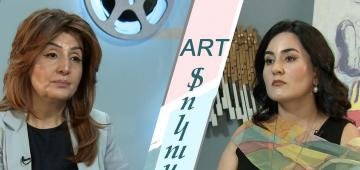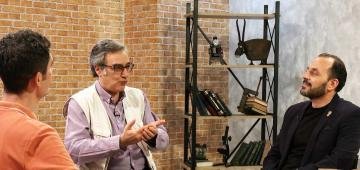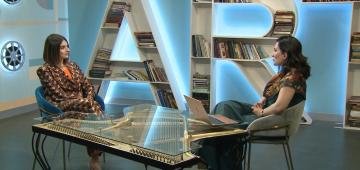 |
"HayArt"'s Content Struggles"HayArt" as a museum of contemporary art, from the day it was founded in 1985 to the present day, is perhaps one of the most troubled cultural structures in the history of Armenia. The building of the Center for Contemporary Art has periodically undergone absurd changes in content. Now they are trying to solve these problems. Anahit Margaryan spoke with Sona Harutyunyan, the acting director of "HayArt" in "Artfocus". |
 |
Hrant Matevosyan: I am the master of my time, part 2Starting from Hrant Matevosyan's first works, the elimination of the perception of the owner of his country and land, as well as time, is key from within the human being, from the Armenian person. How do Matevosyan's heroes respond to this situation, what solutions does the author offer? The "Parallel Readings" program discusses literary critics Hayk Hambardzumyan, Arkmenik Nikoghosyan, and writer and publicist Gevorg Ter-Gabrielyan. |
 |
The path of painter Gevorg GrigoryanThe artistic thinking of the painter Gevorg Grigoryan was formed in Tbilisi. The late 1920s and early 1930s were the years of the artist's creative rise, when he actively participated in the cultural life of Tbilisi, in exhibitions of Armenian and Georgian artists. In the 50s, his art began to be perceived and revalued in a new way. In 1962, the artist realized his greatest dream, settling in Yerevan with his wife and continuing to create with great enthusiasm until the end of his life. Anahit Margaryan's guest at "Artfocus" is Arpine Saribekyan, director of Gevorg Grigoryan's studio-museum. |
 |
Hrant Matevosyan: I am the master of my time, part 1In many of Hrant Matevosyan's works, one can encounter the idea of owning the land, the country, and time. Who is the owner according to the prose writer, what does it mean to be the owner of time, what is the writer's responsibility or obligation towards his time? The "Parallel Readings" program features discussions with literary critics Hayk Hambardzumyan, Arkmenik Nikoghosyan, and writer and publicist Gevorg Ter-Gabrielyan. |
 |
Hasmik Baghdasarayan-Dolukhanyan's musical projectsSinger Hasmik Baghdasarayan-Dolukhanyan is the author of numerous projects. She organizes concerts with and for children. In addition, she implements a musical project for women over 60. She is an artist of the “Naghash” ensemble and the “Luys” quintet. Art critic Anahit Margaryan hosted Hasmik Baghdasarayan-Dolukhanyan at “Artfocus”. |
 |
Khachik Dashtents' novel "The Call of the Ranch Dancers"The main characters of Khachik Dashtents' novel "The Call of the Ranch Dancers" are leaders of the national liberation movement: Zoravar Andranik, Gevorg Chaush, Aghbyur Serob, Makhluto and others, and the story is woven around the heroic and unbreakable spirit of the people. The 115th anniversary of Khachik Dashtents' birth is approaching, and literary critics Hayk Hambardzumyan and Arkmenik Nikoghosyan discuss the author's famous novel on the "Parallel Readings" program. |
 |
Bovurkhan Monastery in Artsakh
Bovurkhan Monastery is located in the Martuni region of the Republic of Artsakh. It was built in the 17th century, in the historical Varanda province of Artsakh. The monastery complex was the summer residence of the Varanda meliks. In 2023, the monastery was annexed by Azerbaijan along with the Nagorno-Karabakh Republic.
The Bovurkhan Monastery Complex is under the jurisdiction of the Artsakh Diocese of the Armenian Apostolic Church.
|
 |
Armenian Heritage Scanning ProgramSince 2020, the preservation of the historical, cultural and religious heritage of Artsakh has become a critical issue. Since 2020, the TUMO Center for Creative Technologies has launched the “Global Armenian Heritage Scanning Initiative” program, the goal of which is to document, preserve and make Armenian historical and cultural monuments accessible to the public, specialists engaged in the reconstruction and restoration of monuments, and researchers. In “Artfocus,” Anahit Margaryan discussed the topic with Hule Keshishyan, Senior Manager of the 3D Scanning Project at the TUMO Creative Center. |
 |
World dramaturgy in Armenian: who is the addressee?In recent years, there has been great activity in translating world drama into Armenian. Moreover, many of the playwrights are being performed in Armenian for the first time. At the same time, Armenian theaters do not seem to be using these translations. Why is world drama translated, for the reader or for the theater? These questions are discussed in the program “Parallel Readings” by literary critics Hayk Hambardzumyan, Arkmenik Nikoghosyan, and translator, film critic Zaven Boyajyan. |
 |
St. Ascension Church in Artsakh
The Church of the Holy Ascension in Berdzor is the first church in the Nagorno-Karabakh Republic to declare independence in the 20th century. It was consecrated on May 31, 1998.
The church, along with the city of Berdzor, came under the control of the Azerbaijani armed forces in 2022. Satellite photos from May 2024 show that it was completely destroyed by Azerbaijan.
The deliberate destruction of the church is a gross violation of international law and is considered a grave crime against humanity.
|
 |
Gandzasar in Artsakh
Gandzasar Monastery is located in the Martakert region of the Republic of Artsakh, near the village of Vank. Hasan Jalal Dolan, the prince of the Khachen province of Artsakh, began the construction of the St. John Church in 1216. The construction lasted 22 years.
In 2023, the monastery, along with the Nagorno-Karabakh Republic, was annexed by Azerbaijan. Gandzasar Monastery is under the jurisdiction of the Artsakh Diocese of the Armenian Apostolic Church.
|
 |
Shoshkavank in ArtsakhShoshkavank is located in the Martuni region of the Republic of Artsakh, on a mountain peak between the villages of Msmna and Khachmach. In 2023, the monastery was occupied by Azerbaijan along with the Nagorno-Karabakh Republic. Shoshkavank is under the jurisdiction of the Artsakh Diocese of the Armenian Apostolic Church. |
